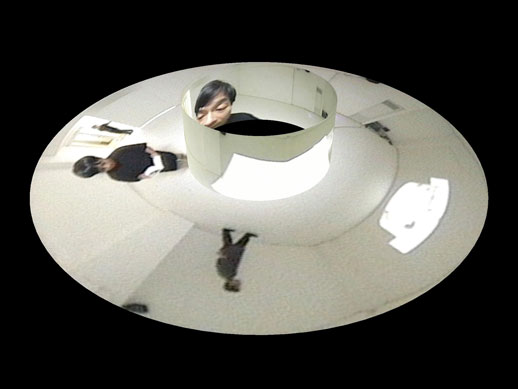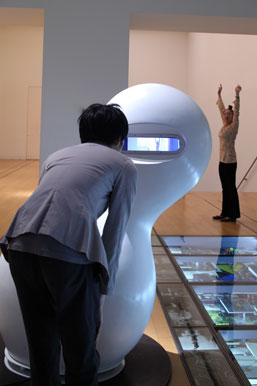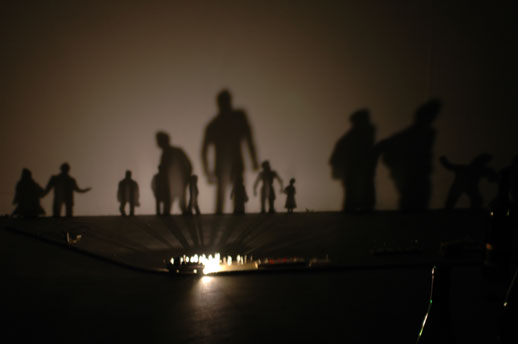Open Space 2010: Opening doors towards technology and art
“Open Space 2010”, the fourth annual long-term exhibition presented by the NTT Inter Communication Center, is a unique and interactive collection of works that aims to be a dialogue between cutting-edge art practices and communication technologies. It includes a gallery featuring installation works by several artists, prominent both in Japan and overseas; a library; an archive of past materials from the ICC collection (the Hive); a corner which features emerging artists; a Science Lab; an Illusion Forum; and a Kids Lounge. The theme of communication and user-based technologies aligning with the philosophy of the ICC and Open Space is clearly evident.
In this case, video and digital art installation is the dominant medium, with the artists utilizing digital technologies according to their specific concept. ‘Flat Scope Scape MJ’ (Asao Tokolo, 2010) is striking in its simplicity of arrangement, and yet elegant in its exploration of geometric patterns that question the shifting nature of movement. With just the use of three cameras, a projector and three stands that invite you to move and rotate the ‘discs’ of patterns, an entire wall behind you becomes instantaneously changed by the patterns that you in fact, manipulate.
Real-time and audience participation is again a theme explored by the ‘Marshmallow Scope’ (Toshio Iwai, 2002), a large white marshmallow-like object with a video camera installed inside, so that essentially we view the gallery-room through its ‘eyes.’ The work is contingent on the visual changes that occur as people walk in and out of the camera’s span of vision.

‘Morel’s Panorama’ (Masaki Fujihata, 2003) displays similarities with Tokolo and Iwai’s works in its dependence on the audience to create the art, through a camera or some other means of projection. The stark white room, the voice-over of the artist and the panoramic camera installed in the center, is effective in the distortion and misrepresentation of our projected image as we engage in the exploration of the artwork.
 Jen Brand’s ‘The G-G-G Tokyo Outlet: One World – Three Players’ (2004-2010), includes the GP4 (a global hi-fi), the Global Player, the G-Pod and the website g-turns.com. The concept is interesting and ambitious in its articulation of the notion ‘the earth as a disc.’ Essentially, these tools function as collectors of satellite data that connects the topographical layout of the earth and turns it into sound. Brand plays on our Apple-dominated cultural consciousness and invites the users to interpret the ideological and sociological implications of the work.
Jen Brand’s ‘The G-G-G Tokyo Outlet: One World – Three Players’ (2004-2010), includes the GP4 (a global hi-fi), the Global Player, the G-Pod and the website g-turns.com. The concept is interesting and ambitious in its articulation of the notion ‘the earth as a disc.’ Essentially, these tools function as collectors of satellite data that connects the topographical layout of the earth and turns it into sound. Brand plays on our Apple-dominated cultural consciousness and invites the users to interpret the ideological and sociological implications of the work.
In the next room is ‘A Parallel Image’ (Gebhard Sengmuller and Franz Buchinger 2008), a wonderfully delicate and equally mysterious installation. Two panels are suspended from the ceiling and are connected by an almost floating mass of copper wires. 2500 tiny light-bulbs are attached to one panel while the other panel acts as a reflector. When someone stands on the reflector side, the person standing on the receptor side experiences the silhouette ‘drawn’ by the light-bulbs, thus an image is created through this parallel structure. Both form and concept was executed beautifully, elevating this work from what could have been a mere science and technology experiment to a sophisticated conceptual art installation.
Without a doubt, the work which engages the viewer most effectively is ‘The 10th Sentiment’ by Ryota Kuwakubo (2010). Stunning in its simplicity, the pitch-black room becomes only partially visible through the tiny headlight of the toy train that travels around a make-shift railway track. The room is transformed into a shadowy world, an urban nightscape through the clever use of everyday objects (the Tupperware-turned-tunnel was a personal favorite). We, the viewers, are engulfed by the moving shadows and become an inherent part of the artwork.

The eerie and almost claustrophobic ‘Anechoic room’ (Keiichiro Shibuya and evala, ‘for maria anechoic room version’) is certainly also an experience not to be missed. In terms of curatorship, the work is thematically bound by the recurring elements of audience-interaction as a vital component in the making of the work, as well as the philosophical relationship between art and technology. Yet the density and the sheer overwhelming ability of the room to remove your sense of sound and being, is what sets this work apart. Initially conceived as a space for total silence and meditation, the foremost avant-garde composer John Cage once participated in the experience of the room with its sound-compressing walls, which would ultimately become the inspiration for his masterpiece “4’33”.
As a whole collection, “Open Space 2010” is a refreshing, educational, and thought-provoking look at what the future holds for the arts and media, technology and communication.
Mio Coxon
Mio Coxon


